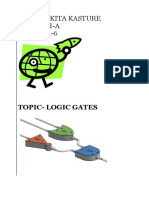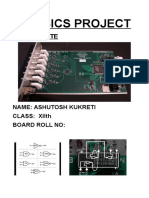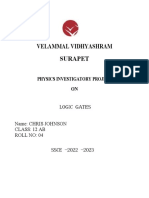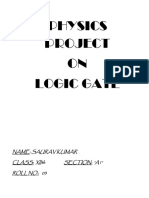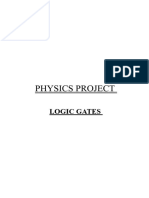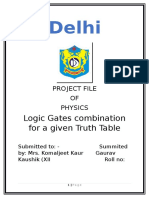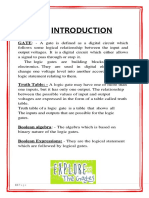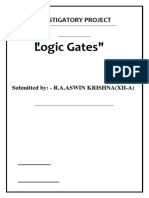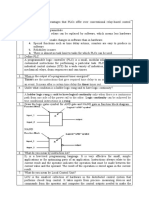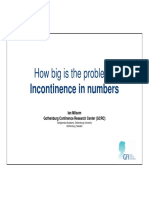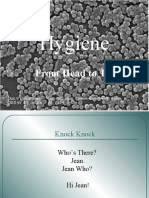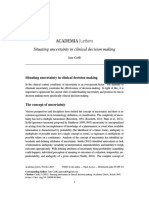INTRODUCTION
A gate is defined as a digital circuit which follows some logical relationship between the
input and output voltages. It is a digital circuit which either allows a signal to pass through as
stop, it is called a gate.
The logic gates are building blocks at digital electronics. They are used in digital electronics
to change on voltage level (input voltage) into another (output voltage) according to some
logical statement relating them.
A logic gate may have one or more inputs, but it has only one output. The relationship
between the possible values of input and output voltage is expressed in the form of a table
called truth table or table of combination.
Truth table of a Logic Gates is a table that shows all the input and output possibilities for the
logic gate.
George Boole in 1980 invented a different kind of algebra based on binary nature at the
logic, this algebra of logic called BOOLEAN ALGEBRA. A logical statement can have only
two values, such as HIGH/LOW, ON/OFF, CLOSED/OPEN, YES/NO, RIGHT/WRONG,
TRUE/FALSE, CONDUCTING/NON-CONDUCTING etc. The two values of logic
statements one denoted by the binary number 1 and 0. The binary number 1 is used to denote
the high value. The logical statements that logic gates follow is called Boolean expressions.
1|Page
� PRINCIPLE
Any Boolean algebra operation can be associated with inputs and outputs represent the
statements of Boolean algebra. Although these circuits may be complex, they may all be
constructed from three basic devices. We have three different types of basic logic gates.
These are the AND gate, the OR gate and the NOT gate.
LOGIC STATES
1 0
High Low
+ve -ve
On Off
Close Open
Right Wrong
True False
Yes NO
BASIC GATES
2|Page
�(a) THE OR GATE is a device that combines A with B to give Y as the result. The OR gate
has two or more inputs and one output. The logic gate of OR gate with A and B input and
Y output is shown below.
In Boolean algebra, addition symbol (+) is referred as the OR. The Boolean expression:
A+B=Y, indicates Y equals A OR B.
(b) THE AND GATE is a device that combines A with B to give Y as the result. The AND
gate has two or more inputs and one output. The logic gate of AND gate with A and B input
and Y output is shown below:
In Boolean algebra, multiplication sign (either x or.) is referred as the AND. The Boolean
expression: A.B=Y, indicates Y equals A AND B.
3|Page
�(b) THE NOT GATE is a device that inverts the inputs. The NOT is a one input and one
output. The logic gate of NOT gate with A and Y output is shown below:
In Boolean algebra, bar symbol (_) is referred as the NOT. The Boolean expression: X’ =Y,
indicates Y equals NOT A
OR GATE
AIM:
4|Page
�To design and simulate the OR gate
COMPONENTS:
Two ideal p-n junction diode (D1 and D2).
THEORY AND CONSTRUCTION:
An OR gate can be realized by the electronic circuit, making use of two diodes D1 and D2 as
shown in the figure.
Here the negative terminal of the battery is grounded and corresponds to the 0 level, and the
positive terminal of the battery (i.e. voltage 5V in the present case) corresponds to level 1.
The output Y is voltage at C w.r.t. earth.
INFERENCE
The following interference can be easily drawn from the working of electrical circuit is:
a) If switch A & B are open lamp do not glow (A=0, B=0), hence Y=0.
b) If Switch A open B closed then (A=0, B=1) Lamp glow, hence Y=1.
c) If switch A closed B open then (A=1, B=0) Lamp glow, hence Y=1.
d) If switch A & B are closed then (A=1, B=1) Lamp glow, hence Y=1.
AND GATE
AIM:
5|Page
�To design and simulate the AND gate.
COMPONENTS:
Two ideal p-n junction diode (D1 and D2), a resistance R.
THEORY AND CONSTRUCTION:
An AND gate can be realized by the electronic circuit, making use of two diodes D1 and D2
as shown in the figure. The resistance R is connected to the positive terminal of a 5V battery
permanently.
Here the negative terminal of the battery is grounded and corresponds to the 0 level, and the
positive terminal of the battery (i.e. voltage 5V in the present case) corresponds to level 1.
The output Y is voltage at C w.r.t. earth.
INFERENCE:
The following conclusions can be easily drawn from the working of electrical circuit:
a) If both switches A&B are open (A=0, B=0) then lamp will not glow, hence Y=0.
b) If Switch A closed & B open (A=1, B=0) then Lamp will not glow, hence Y=0.
c) If switch A open & B closed (A=0, B=1) then Lamp will not glow, hence Y=0.
d) If switch A & B both closed (A=1, B=1) then Lamp will glow, hence Y=1.
NOT GATE
AIM:
6|Page
�To design and simulate the NOT gate.
COMPONENTS:
An ideal n-p-n transistor.
THEORY AND CONSTRUCTION:
A NOT gate cannot be realized by using diodes. However, an electronic circuit of NOT gate
can be realized by making use of a n-p-n transistor as shown in the figure.
The base B of the transistor is connected to the input A through a resistance Rb and the
emitter E is earthed. The collector is connected to 5V battery. The output Y is voltage at C
w.r.t. earth.
INFERENCE:
The following inference can be easily drawn from the working of the electrical circuit:
a) If switch A is open (i.e. A=0), the lump will glow, hence Y=1.
b) If Switch A is closed (i.e. A=1), the lump will not glow, hence Y=0.
NOR GATE
AIM:
7|Page
�To simulate and design the NOR gate.
COMPONENTS:
Two ideal p-n junction diode (D1 and D2), an ideal n-p-n transistor.
THEORY AND CONSTRUCTION:
If we connect the output Y’ of OR gate to the input of a NOT gate the gate obtained is called
NOR. The output Y is voltage at C w.r.t. earth.
In Boolean expression, the NOR gate is expressed as Y=A+B, and is being read as ‘A OR B
negated’
INFERENCE:
. The following interference can be easily drawn from the working of electrical circuit is:
a) If Switch A & B open (A=0, B=0) then Lamp will glow, hence Y=1.
b) If Switch A closed & B open (A=1, B=0) then Lamp will not glow, hence Y=0.
c) If Switch A open & B close (A=0, B=1) then Lamp will not glow, hence Y=0.
d) If switch A & B are closed then (A=1, B=1) Lamp will not glow, hence Y=0.
NAND GATE
8|Page
�AIM:
To design and simulate NAND gate
COMPONENTS:
Two ideal p-n junction diode (D1 and D2), a resistance R, an ideal n-p-n transistor.
THEORY AND CONSTRUCTION:
If we connect the output Y’ of AND gate to the input of a NOT gate the gate obtained is
called NAND. The output Y is voltage at C w.r.t. earth.
In Boolean expression, the NAND gate is expressed as Y=A.B, and is being read as ‘A AND
B negated’
INFERENCE:
The following interference can be easily drawn from the working of electrical circuit:
a) If Switch A & B open (A=0, B=0) then Lamp will glow, hence Y=1.
b) If Switch A open B closed then (A=0, B=1) Lamp glow, hence Y=1.
c) If switch A closed B open then (A=1, B=0) Lamp glow, hence Y=1.
d) If switch A & B are closed then (A=1, B=1) Lamp will not glow, hence Y=0.
EX-OR GATE
9|Page
�AIM:
To simulate and design the EX-OR gate.
COMPONENTS:
Two AND gate, an OR gate, two NOT gate.
THEORY AND CONSTRUCTION:
The operation EX-OR checks for the exclusivity in the value of the two signals A and B. It
means if A and B are not identical (i.e. if A=0 and B=1 or vice versa), the output Y=1, and if
both are identical, then the output Y=0. This operation is also called exclusive OR gate,
designated EX-OR.
In Boolean expression, the EX OR gate is expressed as Y=A’.B + A.B’
INFERENCE:
The following interference can be easily drawn from the working of electrical circuit:
a) If both switches A&B are open (A=0, B=0) then lamp will not glow, hence Y=0.
b) If Switch A open B closed then (A=0, B=1) Lamp glow, hence Y=1.
c) If switch A closed B open then (A=1, B=0) Lamp glow, hence Y=1.
d) If switch A & B are closed then (A=1, B=1) Lamp will not glow, hence Y=0.
10 | P a g e
� EX-NOR GATE
AIM:
To simulate and design EX-NOR gate.
COMPONENTS:
Two AND gate, an OR gate, and two NOT gate.
THEORY AND CONSTRUCTION:
The operation EX-NOR checks for the exclusivity in the value of the two signals A and B. It
means if A and B are not identical (i.e. if A=0 and B=1 or vice versa), the output Y=0, and if
both are identical, then the output Y=1. This operation is also called exclusive NOR gate,
designated EX-NOR.
In Boolean expression, the EX NOR gate is expressed as Y=A.B + A’.B’
INFERENCE:
The following interference can be easily drawn from the working of electrical circuit:
a) If Switch A & B open (A=0, B=0) then Lamp will glow, hence Y=1.
b) If Switch A closed & B open (A=1, B=0) then Lamp will not glow, hence Y=0.
c) If Switch A open & B close (A=0, B=1) then Lamp will not glow, hence Y=0.
d) If switch A & B both closed (A=1, B=1) then Lamp will glow, hence Y=1.
11 | P a g e
� RESULT:
After designing the gates, we found that all the gates follow a unique truth table respectively.
1) OR GATE
2) AND GATE
3) NOT GATE
12 | P a g e
� 4) NOR GATE
5) NAND GATE
6) EX-OR GATE
13 | P a g e
� 7) EX- NOR GATE
14 | P a g e
� SOME COMMON APPLICATION OF LOGIC
GATES
During the course of discussion about various digital logic gates, we have mainly
discussed about the design, property and operation of them. In this article we will look
at various applications of logic gates. Their applications are determined mainly based
upon their truth table i.e. their mode of operations. In the following discussion we will
look at the applications of basic logic gates as well as many other normal logic gates
as well.
1) Application of OR gate
Wherever the occurrence of any one or more than one event is needed to be detected
or some actions are to be taken after their occurrence, in all those cases OR gates can
be used. It can be explained with an example. Suppose in an industrial plant if one or
more than one parameter exceeds the safe value, some protective measure is needed to
be done. In that case OR gate is used. We are going to show this with the help of a
diagram. The above figure is a typical schematic diagram where an OR gate is used to
detect exceed of temperature or pressure and produce command signal for the system
to take required actions.
2) Application of AND gate
There are mainly two applications of AND gate as Enable gate and Inhibit gate.
Enable gate means allowance of data through a channel and Inhibit gate is just the
reverse of that process i.e. disallowance of data through a channel. We are going to
show an enabling operation to understand it in an easier way. Suppose in the
measurement of frequency of a pulsed waveform. For measurement of frequency a
gating pulse of known frequency is sent to enable the passage of the waveform whose
frequency is to be measured. The diagram below shows the arrangement of the above
explained operation.
15 | P a g e
� 3) Application of EX-OR and EX-OR gates
These type of logic gates are used in generation of parity generation and checking
units. The two diagrams below show the even and odd parity
generator circuits respectively for a four data.
With the help of these gates parity check operation can be also performed. The
diagrams below show even and odd parity check.
Figure (a) shows the parity check using Ex-OR gates and the figure (b) shows the
parity check using Ex-NOR gates.
4) Application of NOT gate or Inverters
NOT gates are also known as inverter because they invert the output given to them
and show the reverse result. Now the CMOS inverters are commonly used to build
square wave oscillators which are used for generating clock signals. The
advantage of using these is they consume low power and their interfacing is very
easy compared to other logic gates.
16 | P a g e













